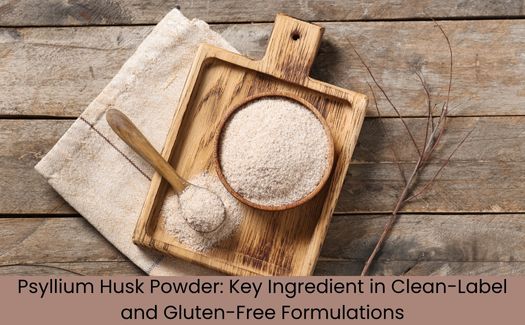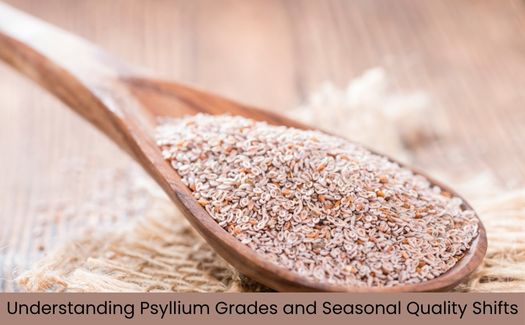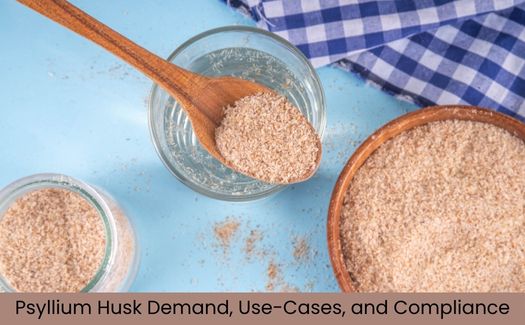Psyllium – derived from Plantago ovata – has evolved from a traditional digestive aid into a global, multi-industry ingredient. Three commercial forms dominate trade: seeds (the agricultural base and a traditional remedy), husk (the fiber-rich seed coat), and husk powder (finely milled for superior dispersibility). Each serves distinct end uses: nutraceutical capsules and sachets, gluten-free baking, clinical nutrition, functional beverages, fiber-fortified staples, and even specialized industrial applications.
The demand curve is rising because psyllium solves a simple, universal problem: the world’s fiber intake is too low. As consumers chase gut comfort, heart health, and weight management – while brands chase clean labels and better texture in gluten-free foods – psyllium offers both function and story. On the supply side, India anchors the ecosystem with concentrated know-how from farm to factory, while a growing network of global buyers – from the United States and Canada to Europe, East Asia, the Middle East, and Latin America – pulls steadily at all three product forms. Against this structural strength, short-term variables like freight rates, currency swings, and tax classifications can tighten or loosen trade, making agility and planning just as important as price.
Most populations under-consume dietary fiber. Psyllium bridges that gap with high soluble fiber density in small serving sizes. For consumers, it’s an easy daily ritual that can help normalize bowel movements and support cholesterol and glycemic management goals. For brands, it’s a credible, plant-based way to formulate “digestive health” and “heart smart” claims where local regulations allow.

Psyllium husk powder is a quiet workhorse in product development:
From pharmacy aisles to grocery shelves and online marketplaces, psyllium travels well in both bulk bags and single-serve sachets. Consumer habits – morning smoothies, pre-meal fiber water, and gluten-free home baking – have made demand less seasonal and more recurring. Education content (from dietitians to fitness creators) has expanded the use-case from “occasional laxative” to “everyday fiber.”
India is the engine of global psyllium. Semi-arid conditions favor Plantago ovata, and decades of specialization have created a robust chain:
The result is reliable volume, wide grade availability, and competitive cost-in-use – key reasons multinational food and nutraceutical companies anchor supply contracts in India.
Neighboring countries cultivate and ship smaller volumes, while some destinations import semi-finished psyllium for local milling, blending, or private labeling. Yet, on scale, yield, and grade breadth, India remains the reference point most buyers plan around.
Grades, seasonality, and quality determinants

Psyllium shipments are typically declared under the “plants/parts used for pharmacy/food” family of HS codes (sub-lines differ by country). Commercial buyers will usually require:
Clear documentation and correct HS mapping reduce customs queries and port delays.
Landed cost is a moving target shaped by:
Purity is a primary pricing lever. The step from 85%→95% brings noticeable functionality gains in bakery and blends. 99%+ purity is the benchmark for premium beverages, clinical nutrition, and capsules – where clarity, mouthfeel, and label claims matter most.
Quick context: India remains the anchor origin for psyllium seeds, psyllium husk, and psyllium husk powder. Buyers typically choose purity grades of 85%, 95%, or 99%+ and specify mesh sizes for bakery vs. beverage vs. capsule needs. Microbiology, pesticide residues, heavy metals, and labeling rules vary by market, so tailor specs early in the RFQ.

Start with where the ingredient will live: beverage, bakery, capsule/sachet, clinical nutrition, or value retail. Each use dictates purity, mesh, microbiology, and documentation. Reverse-engineer the spec before you RFQ.
Prioritize processors with:
Request 2–3 pilot lots per target grade/mesh. In your lab, measure: hydration rate, viscosity curve, color (Lab*), sensory in the final matrix, sieve profile, flowability, and capsule fill performance (if relevant). Keep a small panel blind taste to catch mouthfeel issues early.
Application | Recommended Purity | Typical Mesh | Notes |
Ready-to-mix beverages / shots | 95–99%+ | Fine (e.g., 70–100 mesh equivalent) | Fast hydration, smooth mouthfeel, low bioburden; color uniformity matters. |
Capsules / sachets | 95–99%+ | Free-flowing fine | Focus on bulk density, flow, and low micro; avoid caking. |
Gluten-free bakery (bread, tortillas, pizza) | 85–95% | Medium | Structure/crumb elasticity; pilot for water absorption to set dough yield. |
High-fiber snacks & cereals | 85–95% | Medium to coarse blend | Balance crunch vs. binding; watch moisture migration. |
Clinical / medical nutrition | 99%+ | Fine | Tightest micro/residue specs; reproducible viscosity is critical. |
Value retail bulk husk | 85–95% | Medium | Cost-in-use focus; clear, compliant label and basic micro/residue panel. |
Pro tip: Start with the higher purity during development, then cost-engineer by stepping down purity or blending meshes only if sensory and claims remain intact.
Psyllium has moved decisively from niche herbal shelves into the center of modern food, beverage, nutraceutical, and clinical nutrition supply chains. The appeal is simple and durable: a concentrated, plant-based source of soluble fiber that solves real consumer needs – digestive comfort, cardiometabolic support, satiety – while also giving formulators clean-label functionality. Globally, demand is broad and resilient: North America and Western Europe remain anchor markets; East Asia, the Middle East, and pockets of Latin America are scaling fast; Bangladesh and several African economies provide steady, value-driven pull.
On the supply side, India’s farm-to-factory ecosystem still sets the pace on volume, grade diversity, and cost-in-use. That concentration brings efficiency – yet it also means buyers should plan around seasonal yields, logistics cycles, and policy interpretations that can influence prices and lead times. The winners in this category aren’t just the lowest-cost buyers or sellers; they’re the ones who match grade to application, lock in repeatable quality, and tell a credible origin and sustainability story.
Whether you are an exporter, importer, brand owner, or formulator, psyllium’s next three years will reward those who standardize specs, diversify lanes, and invest in consumer education. The category may look like “just fiber,” but it’s really a high-trust, performance ingredient – one that delivers when purity, mesh, microbiology, and documentation are treated as strategic, not tactical.
REG.NO: SCC/IN/QMS/1168